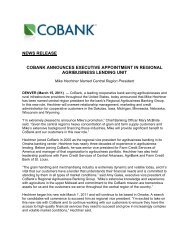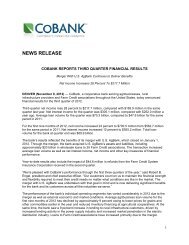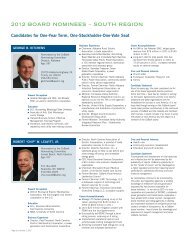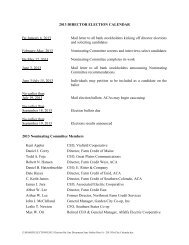In August 2009, we exchanged $136.8 million of Series Apreferred stock for Series D preferred stock. The exchangewas completed to enhance the quality and durability of ourcapital. For regulatory capital purposes, our Series D preferredstock is included in permanent capital, total surplus and coresurplus, whereas our Series A preferred stock is included onlyin permanent capital and total surplus. In connection with theexchange, holders of the Series A preferred stock voted toeliminate certain restrictions on our ability to make openmarket purchases or exchanges of the Series A preferredstock.In August 2011, we amended the certificates ofdesignation of our Series C and Series D preferred stock torank on parity with Series A and Series B preferred stock as todividend distributions or distributions upon liquidation. Ourpreferred stock is discussed in Note 7 to the accompanyingconsolidated financial statements.At December 31, 2011, we had $1.0 billion insubordinated debt outstanding. For regulatory capitalpurposes, subject to certain limitations, subordinated debt isincluded in permanent capital and total surplus and excludedfrom liabilities in the net collateral ratio. Our subordinateddebt is discussed in Note 6 to the accompanying consolidatedfinancial statements.We may from time to time seek to retire our outstandingdebt or equity securities through calls, cash purchases and/orexchanges, in open market purchases, privately negotiatedtransactions or otherwise. Such repurchases or exchanges, ifany, will depend on prevailing market conditions, the Bank’scapital position and liquidity requirements, contractualrestrictions and other factors. The amounts involved may bematerial.FCA regulations include requirements to maintainregulatory capital at or above minimum levels for ourpermanent capital ratio, total surplus ratio, core surplus ratio,and net collateral ratio. The calculation of these ratios issummarized in Note 7 to the accompanying consolidatedfinancial statements. If these standards are not met, the FCAcould impose restrictions, including limiting our ability to paypatronage distributions, retire equities and pay preferred stockdividends. As displayed in the following table, atDecember 31, 2011, 2010 and 2009, we exceeded theminimum regulatory requirements, which are notedparenthetically.Selected Capital Information ($ in Millions)December 31,2011 2010 2009Total Shareholders’ Equity $ 4,896 $ 4,406 $ 4,058Total Shareholders’ Equity/Total Assets 7.74 % 6.69 % 6.98 %Permanent Capital Ratio (7.0%) 16.37 14.30 15.29Total Surplus Ratio (7.0%) 16.01 13.96 15.01Core Surplus Ratio (3.5%) 10.02 8.42 8.77Net Collateral Ratio (104.0%) (1)(2) 109.05 108.03 108.67(1)The regulatory minimum net collateral ratio is 103.0 percent, but the FCArequires the higher 104.0 percent during the period in which we have Series Apreferred stock or subordinated debt outstanding.(2) As a condition of the merger with AgBank, from January 1, 2012 throughDecember 31, 2014, if the net collateral ratio falls below 105.0 percent, the Bankmust notify the FCA and submit to them a written plan to restore and maintaina level of at least 105.0 percent.Pursuant to FCA guidance, effective July 1, 2011, webegan phasing out our Series A preferred stock($163.3 million at December 31, 2011) from our permanentcapital, total surplus and net collateral amounts at a rate of20 percent per annum. The impact to our regulatory capitaland collateral ratios was less than 0.1 percent during 2011.Also pursuant to FCA guidance, a significant portion ofour common stock is included in core surplus, subject tocertain conditions. This inclusion will continue on a temporarybasis until the earlier of December 31, 2012 or the point atwhich the FCA changes its capital regulations in a manner thatwould be inconsistent with this treatment. The FCA requiresthat we also calculate our core surplus ratio excludingcommon stock and has established a 3.0 percent minimum forsuch ratio. As of December 31, 2011, our core surplus ratioexcluding common stock was 7.91 percent. As a condition ofthe merger with AgBank, from January 1, 2012 throughDecember 31, 2014, if our core surplus ratio excludingcommon stock falls below a threshold level, the Bank mustnotify the FCA and submit to them a written plan to restoreand maintain the ratio to at least that level. The core surplusratio excluding common stock was above the threshold levelas of the date of the merger.The FCA has issued Advance Notices of ProposedRulemaking on capital adequacy which could ultimately leadto significant changes in the System’s regulatory capital rules.<strong>CoBank</strong> 2011 <strong>Annual</strong> <strong>Report</strong>57
In accordance with the Farm Credit Act, cooperatives andother eligible borrowers are required to purchase equity in<strong>CoBank</strong> as a condition of borrowing. Eligible borrowers thatborrow on a patronage basis have voting rights while they areactive borrowers. Generally, for borrowers other thanaffiliated Associations, the minimum initial borrowerinvestment is equal to the lesser of one thousand dollars or2 percent of the amount of the loan. The minimum initialinvestment is generally received by <strong>CoBank</strong> in cash at thetime the borrower receives the loan proceeds. AffiliatedAssociations provide an initial and ongoing voting stockinvestment of 4 percent of their loan balance. Collectively, thecustomer-owners that hold voting stock elect our Board ofDirectors. We operate on a cooperative basis and return aportion of our earnings to our customer-owners in the form ofpatronage distributions.In March 2009, our voting shareholders approved changesto our bylaws to convert all previously existing classes ofcommon equity, including non-voting participationcertificates, into a single class of common equity – Class Acommon stock – and to afford voting rights to certainborrowers that are not organized as cooperatives. Class Ashareholders that are directly eligible to borrow from <strong>CoBank</strong>,that borrow on a patronage basis and that are active borrowershave voting rights. All other shareholders do not have votingrights. The number of voting shareholders increased byapproximately 27 percent as a result of these bylaw changes,which were effective April 1, 2009.In conjunction with the annual business and financialplanning process, the Board of Directors reviews and approvesa capital adequacy plan which includes capital targets andcapital ratio baselines. The Board determines a targeted equitylevel based on projected asset levels, earnings, economicconditions, possible credit losses and other contingencies. TheBoard also balances the amount required to properly capitalizethe Bank with the desire to distribute a level of patronage thatprovides appropriate returns to our customer-owners. TheBoard may increase or decrease these patronage levels(provided we remain within the regulatory capital minimums)based on its ongoing evaluation of the Bank’s business. As aresult, there is no assurance that patronage will remain atcurrent levels.When reviewing the capital adequacy plan, the Boardconsiders the following: risk diversification of the loanportfolio, loan seasonality, anticipated future capital needs,equity levels required by the Bank’s proprietary economiccapital model, the Bank’s capital levels in comparison tocommercial banks and the regulatory minimum capitalstandards. As of December 31, 2011, the Board-establishedcapital ratio baselines were 10 percent for the permanentcapital and total surplus ratios, and 5 percent for the coresurplus ratio. As part of our business planning process, weperform stress tests to examine the Bank’s financial conditionand performance under a variety of market and economicenvironments, including unanticipated loan growth andprolonged periods of financial and loan quality stress. Thesetests, which include severe scenarios, illustrate the Bank’sability to continue to maintain compliance with regulatoryrequirements and meet commitments to our stakeholders.Results of these tests are reviewed with the Board ofDirectors.Capital PlansWe have four capital plans that dictate the level of capitalinvestment required by customer-owners. These include a planfor cooperative customers, a plan for affiliated Associations, aplan for nonaffiliated entities and a plan for loan participationspurchased from System entities. The targeted equity level forthe cooperative capital plan is 8 percent of the 10-yearhistorical average loan volume. Additionally, when aborrower’s loans are paid in full, stock is retired over a10-year loan base period beginning in the year following loanpayoff, subject to Board approval and compliance withminimum regulatory capital requirements. The targetedpatronage rate for the cooperative capital plan is expected toremain at 100 basis points of the current year average loanvolume. The cash portion of patronage is 65 percent for allcooperative capital plan members.The capital plan for loan participations purchased fromSystem entities is identical to the cooperative capital plandescribed above.The targeted equity level for the affiliated Associationcapital plan is 4 percent of the one-year historical average loanvolume. There is no stock retirement feature for this capitalplan. The targeted patronage rate for the affiliated Associationcapital plan is expected to remain at 45 basis points of thecurrent year average loan volume with all patronage beingpaid in cash.The targeted equity level for the nonaffiliated entitiescapital plan is 4 percent of the five-year historical averageloan volume. Additionally, when a borrower’s loans are paidin full, stock is retired over a five-year loan base periodbeginning in the year following loan payoff, subject to Boardapproval and compliance with minimum regulatory capitalrequirements. The targeted patronage rate for the nonaffiliatedentity capital plan is expected to remain at 45 basis points ofthe current year average loan volume. The cash portion ofpatronage is 20 percent for all nonaffiliated entity capital planmembers.<strong>CoBank</strong> 2011 <strong>Annual</strong> <strong>Report</strong>58
- Page 4 and 5:
Everett DobrinskiChairmanRobert B.
- Page 6 and 7:
“ We firmly believe the combined
- Page 8 and 9:
associations are partnering with Co
- Page 11 and 12: 2012 BOARD OF DIRECTORSOccupation:F
- Page 13 and 14: “WE ARE COMMITTEDTO GOOD GOVERNAN
- Page 15 and 16: U.S. AgBank CEO Darryl Rhodes (fron
- Page 17 and 18: KansasNew MexicoUtahFC of Ness City
- Page 19 and 20: CorporateCitizenshipAT COBANKSuppor
- Page 21 and 22: StrategicRelationshipsFarm Credit o
- Page 23 and 24: RegionalAgribusinessBANKING GROUPCe
- Page 25 and 26: CorporateAgribusinessBANKING GROUPK
- Page 27 and 28: ElectricDistributionBANKING DIVISIO
- Page 29 and 30: Power SupplyBANKING DIVISIONTri-Sta
- Page 31 and 32: IndustryPortfoliosCoBank ended 2011
- Page 33 and 34: CoBank is a financially strong,depe
- Page 35 and 36: 30COBANK 2011ANNUAL REPORTbuilding
- Page 37 and 38: The information and disclosures con
- Page 39 and 40: Financial Condition andResults of O
- Page 41 and 42: Provision for Loan Losses and Reser
- Page 43 and 44: Purchased services expense decrease
- Page 45 and 46: AgribusinessOverviewThe Agribusines
- Page 47 and 48: Rural InfrastructureOverviewThe Rur
- Page 49 and 50: Credit ApprovalThe most critical el
- Page 51 and 52: Total nonaccrual loans were $134.9
- Page 53 and 54: Basis RiskBasis risk arises due to
- Page 55 and 56: Our net interest income is lower in
- Page 57 and 58: The notional amount of our derivati
- Page 59 and 60: Reputation Risk ManagementReputatio
- Page 61: Investment Securities ($ in Million
- Page 65 and 66: Critical Accounting EstimatesManage
- Page 67 and 68: Business OutlookWe closed our merge
- Page 69 and 70: Consolidated Income StatementsCoBan
- Page 71 and 72: Consolidated Statements of Cash Flo
- Page 73 and 74: Consolidated Statements of Changes
- Page 75 and 76: LoansWe report loans, excluding lea
- Page 77 and 78: If we determine that a derivative n
- Page 79 and 80: Reserve for Credit ExposureThe foll
- Page 81 and 82: The information in the tables under
- Page 83 and 84: The following tables present inform
- Page 85 and 86: At December 31, 2011, gross minimum
- Page 87 and 88: For impaired investment securities,
- Page 89 and 90: At December 31, 2011, the assets of
- Page 91 and 92: Preferred StockThe following table
- Page 93 and 94: The following table provides a summ
- Page 95 and 96: AssumptionsWe measure plan obligati
- Page 97 and 98: Incentive Compensation PlansWe have
- Page 99 and 100: Note 11 - Derivative FinancialInstr
- Page 101 and 102: A summary of the impact of derivati
- Page 103 and 104: Due to the uncertainty of expected
- Page 105 and 106: Assets and Liabilities Measured atF
- Page 107 and 108: Note 14 - Segment Financial Informa
- Page 109 and 110: Note 15 - Commitments and Contingen
- Page 111 and 112: Note 18 - Subsequent Events (Unaudi
- Page 113 and 114:
Supplemental District Financial Inf
- Page 115 and 116:
Supplemental District Financial Inf
- Page 117 and 118:
Report of Independent AuditorsCoBan
- Page 119 and 120:
Management’s Report on Internal C
- Page 121 and 122:
Annual Report to Shareholders Discl
- Page 123 and 124:
Board of Directors Disclosure as of
- Page 125 and 126:
Board of Directors Disclosure as of
- Page 127 and 128:
Board of Directors Disclosure as of
- Page 129 and 130:
Board of Directors Disclosure as of
- Page 131 and 132:
Senior OfficersCoBank, ACBRobert B.
- Page 133 and 134:
Senior Officers Compensation Discus
- Page 135 and 136:
Senior Officers Compensation Discus
- Page 137 and 138:
Senior Officers Compensation Discus
- Page 139 and 140:
Senior Officers Compensation Discus
- Page 141 and 142:
Senior Officers Compensation Discus
- Page 143 and 144:
Senior Officers Compensation Discus
- Page 145 and 146:
Code of EthicsCoBank, ACBCoBank set
- Page 147 and 148:
CERTIFICATIONI, Robert B. Engel, Pr
- Page 149 and 150:
LeadershipCoBank, ACBRobert B. Enge
- Page 151 and 152:
OfficeLocationsCoBank National Offi













